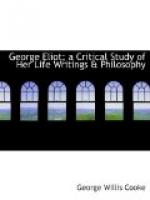When the prejudices aroused by the Jewish element in it are allayed, and Daniel Deronda is read as a work of literary genius, it will be found not to be the least interesting and important of George Eliot’s books. It has the religious interest and inspiration of Adam Bede, the historic value of Romola, and the critical elements of Middlemarch; and these are wrought into a work of lofty insight and imagination, along with a high spiritual ardor and a supreme ethical purpose. In this novel, for the first time, as Professor Dowden says, her poetical genius found adequate expression, and in complete association with the non-poetical elements of her nature.
XVII.
THE SPANISH GYPSY AND OTHER POEMS.
It was The Spanish Gypsy, published in 1868, which brought the name of George Eliot before the public as a poet. This work is a novel written in blank verse, with enough of the heroic and tragic in it to make the story worthy of its poetic form. The story is an excellent one, well conceived and worked out, and had it been given the prose form would have made a powerful and original novel. While it would doubtless have gained in definiteness of detail and clearness of purpose by being presented in the prose form, yet its condensation into a poem is a gain, and the whole setting of the story has been made of greater interest by this method of expression. The poetic form is as original as are the theories of life which the poem is designed to inculcate. In structure it combines, with a method quite its own, the descriptive and dramatic forms of poetry. In this it nearly approaches the method followed in her novels of combining description and dialogue in a unitary structure of great strength and perfection. The descriptive passages in her prose works are strong and impressive, lofty in tone, and yet lovingly faithful in detail. Her conversations are often highly dramatic and add greatly to the whole outcome of these novels. In The Spanish Gypsy the surroundings of the story are first described in verse which, if not always perfectly poetic, is yet imaginatively thought out and executed in a manner befitting the subject. Suddenly, however, the narrative and descriptive form ceases and the dramatic begins. By means also of full “stage directions” to the dramatic portions of the poem, the story is wrought out quite as much in detail as it needs to be; and much is gained of advantage over the length of her novels by this concentration of scene and narrative. While the narrative portion of the poem is much less in extent than the dramatic, yet it has in it some of the main elements of the plot, and those without which the action could not be worked out. The dramatic element gives it a real and living power. The characters are strongly conceived, and nearly all of them are individualities of an original type and of an action thoroughly distinct and human.




